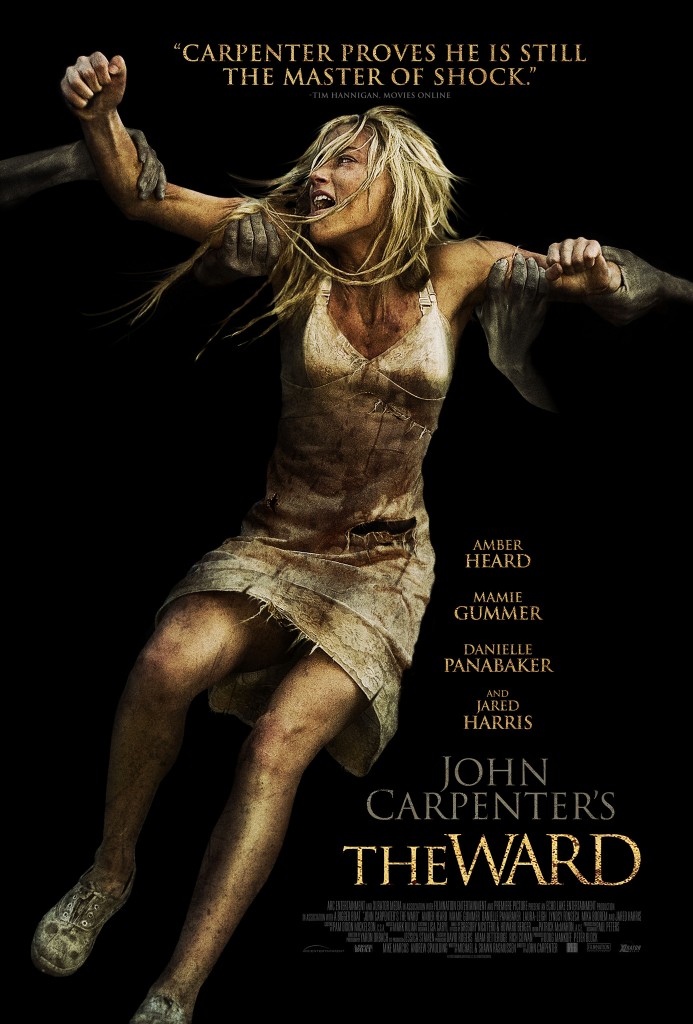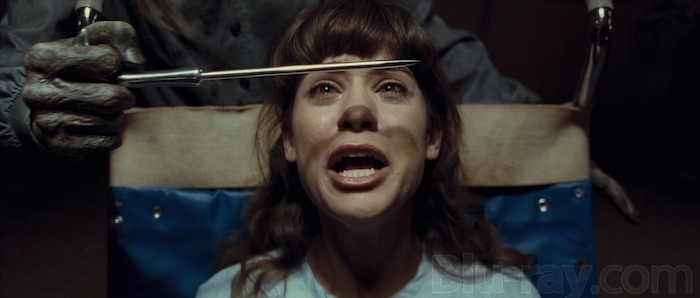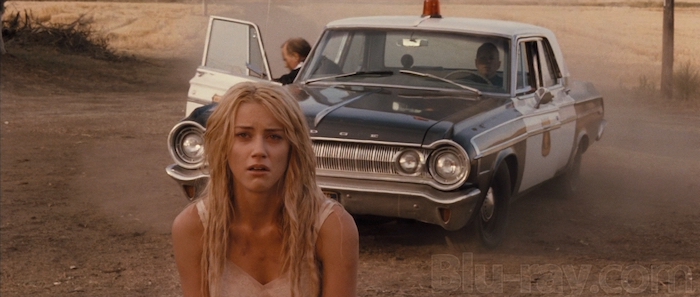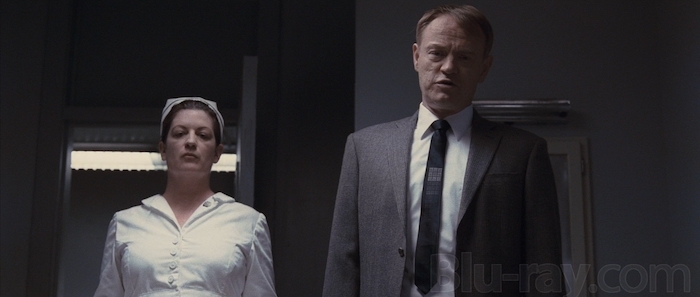The Complete Carpenter: The Ward (2010)
 I started this John Carpenter career overview less than two years ago with Dark Star. Now I’ve come to what may end up as John Carpenter’s final film as director, appropriately a low-budget indie horror film. Carpenter had gone into semi-retirement after Ghosts of Mars flopped at the box office, only directing two episodes of Showtime’s anthology series Masters of Horror over the next nine years. The Ward wasn’t sold as a glorious comeback for the director, but a surreptitious little film that arrived without fanfare in a handful of theaters, a same-day VOD release, and home video a month later.
I started this John Carpenter career overview less than two years ago with Dark Star. Now I’ve come to what may end up as John Carpenter’s final film as director, appropriately a low-budget indie horror film. Carpenter had gone into semi-retirement after Ghosts of Mars flopped at the box office, only directing two episodes of Showtime’s anthology series Masters of Horror over the next nine years. The Ward wasn’t sold as a glorious comeback for the director, but a surreptitious little film that arrived without fanfare in a handful of theaters, a same-day VOD release, and home video a month later.
This isn’t where the Carpenter story ends, thankfully. I doubt he’ll direct another film (never say never), but he’s in a good creative place now. He’s released two superb original albums (Lost Themes, Lost Themes II), tours the country playing shows with his son Cody and godson Daniel Davies, and composed the score for the recent smash-hit installment in the Halloween franchise, which he also executive produced.
This makes me feel a bit better about discussing The Ward, because it’s not the last stop on Carpenter’s career. It won’t be the last article in the series either, since next week I’ll wrap-up two years of the Complete Carpenter with a summary of my five favorite of his movies. I’m not going to list my five worst because I’d prefer to send off this long project — more than 40,000 words — on a feeling of celebration.
But, if you really must know what I movie I’d put at the bottom of the list … it’s The Ward. Easy.
The Story
In 1966, young runaway Kristen (Amber Heard) is sent to a psychiatric hospital in Oregon after she burns down an empty farmhouse. Kristen is placed under the care of Dr. Stringer (Jared Harris), who is looking after five other troubled young women in the hospital’s special psychiatric ward: aggressive Emily (Mamie Gummer), flirtatious Sarah (Danielle Panabaker), artistic Iris (Lyndsy Fonseca), and infantile Zoey (Laura-Leigh). Dr. Stringer believes he can cure Kristen, but Kristen starts to suspect something sinister in the ward is responsible for the disappearance of patients before her. When more vanishings occur, Kristen believes the wrathful ghost of a previous patient, Alice Hudson, is murdering the ward’s occupants. Kristen attempts an escape with the surviving girls before the killer ghosts turns the electroshock therapy machine on her.
The Positives
Major changes in filmmaking technology had occurred since Ghosts of Mars in 2001, and The Ward became the first John Carpenter film since Dark Star not shot in Panavision, the director’s favorite format. Instead, it was shot in Super 35. Even absent the beauty of Panavision lenses, The Ward still looks excellent, and new director of photography Yaron Orbach shows he’s up to the visual challenge of lensing a Carpenter film. The look is standard for horror of the period — grimy browns and industrial grunge — but it’s good for what it is.
The movie was shot in an actual hospital in Spokane, Washington, built in 1891, and it’s a stunning location. The authenticity of outdated and dangerous psychological treatments (shown through historical photographs and sketches in the well-done credits sequence) feels tangibly real when placed in this environment. “The Ward” earns its status as almost the main character, especially when we find out there are far fewer characters in the story than we first thought.
The nineteenth-century building works well at creating a time clash with the ostensible 1966 setting. The production design doesn’t lean heavy on the ‘60s, but it doesn’t need to. The naturalistic approach to the period allows it to become swallowed up by a grotesque Institutional Gothic of seventy years earlier — and that’s just as it should be.
There are no stand-out scares, but since most people find vintage medical equipment unsettling, the scene of Ghost Alice frying poor Sarah using an antiquated electroshock therapy machine until she crisps and bleeds from the mouth is a decent piece of physical horror.
The performances are good across the board, and some of the stranger acting choices feel right because it’s a John Carpenter film and you want a couple of nonsensical weirdos bumping about. Jared Harris is notable playing a character who could conceivably turn into Donald Pleasence’s Dr. Loomis in a few years (although I can’t help wishing Sam Neill into the part). Newcomer Laura-Leigh sells the childish fear of Zoey in a way that adds extra pain to a number of the tenser scenes. Susanna Burney adeptly fills the part of the requisite Super Scary Nurse.
There’s one place in The Ward where something fun, loose, and unexpected happens. In the common room, Sarah puts on a record of “Run Baby Run (Back Into My Arms)” by the Newbeats and the girls all start to dance. It’s cute, creates a frisson between the ‘60s music and the decrepit mental hospital, and makes everybody feel a bit more real for a moment. Suddenly, I envisioned Palmer and Childs watching VHS tapes of game shows to pass the time in The Thing. It’s just a cool touch of the old Carpenter, something out of the ordinary.
The Negatives
It’s a good thing The Ward received little build-up or promotion before its release. Getting any fan’s hopes high about John Carpenter making a spectacular return to horror would’ve been crueler than the psychological contraptions Ghost Alice uses in the actual movie — because The Ward is a big zilch and an artistic low point for Carpenter. It’s flavorless generic 2000s horror; any newcomer director of average promise and a future in nondescript episodic television might have churned out the same movie.
Nothing about The Ward pushes it above the quagmire of other low-budget horror films flooding onto VOD at the same time. It looks like them, it has the same type of cast, the same basic execution, the same droning music score, the same tepid attempt at a mind-screw ending to try to make it feel worthwhile. The main monster is even a J-Horror copycat scary woman with scraggly black hair and gray rotting skin. Seeing something so chewed-over from the creative mind who gifted us with The Thing and In the Mouth of Madness is a sad statement on how much the joy of moviemaking seemed to have abandoned John Carpenter.
I’ve read interviews with Carpenter from when The Ward was released where he explained what drew him to Michael and Shawn Rasmussen’s script in the first place. He liked the single location and the ensemble cast, which recalled many of his best films. But it doesn’t seem as if the story underneath these surface elements grabbed his interest. The real tell about why he picked The Ward is his answer for why he didn’t also compose its score: “too much work.” It’s not so much that Carpenter fell in love with the script as he just found something that wouldn’t be difficult to shoot. And The Ward feels exactly like a director getting through a project without passion.
This is the same attitude Carpenter had about Christine in 1983. That was an already existing script he decided to shoot because he didn’t have any other project at the time. I noted in my review of Christine that a creep of the ordinary got into Carpenter’s work for the first time. But his excitement for filmmaking was still strong. Take away that younger enthusiasm and leave him with a desire to just crank something out, and you have The Ward, which is the ordinary taken to its worst extreme.
This is the only movie in the Carpenter filmography that relies on a surprise ending. This was de rigueur at the time because of the success of early M. Night Shyamalan films and the convolutions of the Saw franchise. The Ward leans hard on its twist, since it doesn’t have much else to bolster it aside from an evocative location. The twist won’t surprise fans of horror and psychological thrillers, or anybody who watched Fight Club. It turns out Kristen isn’t actually Kristen, she’s the missing Alice Hudson. Alice suffered a mental breakdown that drowned her own self and fractured her into multiple personalities. The girls in the ward are her mental fabrications, including Kristen, the most recent personality to emerge. All the “deaths” have been Alice trying to reassert herself and destroy these personalities as Dr. Stringer seeks to cure her.
This reveal suffers from multiple problems. It might have sounded good on paper — a surprise ending enticing viewers to rewatch and re-evaluate the movie because they know most of the characters only exist in the mind of the protagonist. But this only a step away from the worst type of twist ending: “It was all a dream!” With a stroke, none of the horror scenes happened or mattered. It’s one thing to tell an audience to re-contextualize a film with an unusual ending. It’s another to tell them the sequences they showed up to watch never occurred and no one was in danger.
Still, it’s not impossible to pull this off (The Usual Suspects managed something similar), but the twist has to be more interesting than the direction the film was going before. In The Ward, the twist is the less interesting option: I’d rather Alice Hudson was a vengeful spirit exacting justice on her murderers inside a spooky Victorian hospital, which is what the movie and the main character come to believe. There’s no need for a mind-shattering “everything you know is wrong!” reversal, only a smaller surprise near the end, such as implicating Dr. Stringer into Alice’s death so Alice ends up turning on him. (As it is, Dr. Stringer has nothing interesting to do at the climax except explain to Kristen and the audience what was going on.)
The twist ending doesn’t even arrive as much of a surprise. Observant viewers will have picked up from the performances of Kristen’s ward-mates that each is playing a psychological type sketched in broadly Freudian terms. Of course they’ll turn out to be mental fabrications. The ending retroactively explains a few things, such as why Fonseca and Panabaker look absurdly like ‘60s fashion templates, but this doesn’t fix any of these problems on a rewatch.
Amber Heard gives a solid performance, but Kristen is as one-note a character as the other figments of Alice Hudson’s imagination. Kristen is observant and wants to escape, and there’s little else about her to latch onto or care about. She also suffers from the bizarre production choice to make the women in the ward look glamorous all the time. The grouchy nurse tosses Kristen a pile of hand-me-down clothes to change into from her hospital gown, and in the next shot she’s wearing a perfectly tailored outfit for an Abercrombie & Fitch catalog shoot. Choices like this and the many regurgitated horror tropes pull viewers out of the naturalistic setting. Except for the head nurse, who might have been built from parts of the hospital in 1891, nobody feels like they really belong in this movie.
The conclusion has Alice (Mika Boreem) awakening to apparent mental stability as her parents come to visit her in the hospital. Because viewers have only seen Alice in brief snippets of flashbacks and in grotesque ghost form until this point, there’s no emotional connection to her and the coda falls flat. It should’ve been Kristen in the hospital bed, not a character the audience hardly knows. The final jump scare is a predictable bit of business straight from Phantasm (or I Know What You Did Last Summer if you’re not in a generous mood) that closes out the film on the most generic note possible. Which is unfortunately perfect for The Ward.
The Pessimistic Carpenter Ending
Alice is apparently cured, having purged her other identities. Then Kristen comes lunging out of the medicine cabinet at her! Cut to black — and Carpenter has not directed a thing since. Bummer.
Next: My Top Five John Carpenter Movies
Ryan Harvey (RyanHarveyAuthor.com) is one of the original bloggers for Black Gate and has written for the site for over a decade. He received the Writers of the Future Award for his short story “An Acolyte of Black Spires.” His stories “The Sorrowless Thief” and “Stand at Dubun-Geb” are available in Black Gate online fiction. A further Ahn-Tarqa adventure, “Farewell to Tyrn”, is available as an e-book. Ryan lives in Costa Mesa, California. Occasionally, people ask him to talk about Edgar Rice Burroughs or Godzilla.



I honestly didn’t know if I’d seen this one or not until I checked Netflix and saw that I’d rated it & returned it back in 2014. Which I guess says everything you need to know.
Joe, I think I’m going to erase my review and just replace it with that quote.
Aw wait! Why wouldn’t you look at Carpenter’s work for Masters of Horror?
I was interested in what you might have to say about Cigarette Burns. I found it quite different from the director’s other work and liked it enough to watch it twice.
It didn’t seem as good the second time through, but it was still interesting and stood out from the rest of the Masters of Horror episodes.
C’mon! Be a completist! All the kids are doing it!
@Hocking
I remember that episode! It was pretty unsettling. I don’t remember it feeling like a Carpenter movie though. I think Norman Reedus stars in it, and this was before his Walking Dead fame.
There was a film from around the same time starring John Cusack with a strikingly similar plot device. In that, all these different characters wind up stranded at the same hotel. But they all turn out to be split personalities inside a guy’s head at the end. Difference there is, it was a really good movie.
* Just googled it: It was Identity, from 2003.